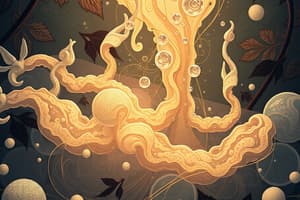Podcast
Questions and Answers
Match the following elements with their atomicity:
Match the following elements with their atomicity:
Copper (Cu) = Monoatomic Oxygen (O2) = Diatomic Ozone (O3) = Polyatomic Gold (Au) = Monoatomic
Match the following properties with the correct type of element:
Match the following properties with the correct type of element:
Malleable, Ductile, Conducts electricity = Metals Not malleable or ductile, Poor conductor of electricity = Non-metals Have properties of both metals and non-metals = Metalloids Good conductors of heat and electricity, Malleability varies = Metals
Match the following terms with their corresponding definitions:
Match the following terms with their corresponding definitions:
Graphite = Consists of a hexagonal lattice of carbon atoms Fullerenes = Carbon atoms bonded in spherical, tubular, or ellipsoidal formations Atomicity = Number of atoms present in the molecule of an element Metals = Elements that are malleable, ductile, and conduct electricity
Match the following statements with the correct category of elements:
Match the following statements with the correct category of elements:
Match the following metals with their properties:
Match the following metals with their properties:
Match the separation technique with its description:
Match the separation technique with its description:
Match the application with the correct usage of centrifugation:
Match the application with the correct usage of centrifugation:
Match the material with the correct application of chromatography:
Match the material with the correct application of chromatography:
Match the item with its correct description in separation techniques:
Match the item with its correct description in separation techniques:
Match the component with its movement during centrifugation:
Match the component with its movement during centrifugation:
Match the solid substance with its method of separation:
Match the solid substance with its method of separation:
Match the following separation techniques with the correct description:
Match the following separation techniques with the correct description:
Match the following substances with their ability to undergo sublimation:
Match the following substances with their ability to undergo sublimation:
Match the following substances that can be separated by sublimation:
Match the following substances that can be separated by sublimation:
Match the following substances with their ability to be separated by magnetic separation:
Match the following substances with their ability to be separated by magnetic separation:
Match the following terms with their corresponding actions in separating mixtures:
Match the following terms with their corresponding actions in separating mixtures:
Match the following substances with their primary method of separation from mixtures:
Match the following substances with their primary method of separation from mixtures:
Flashcards are hidden until you start studying




